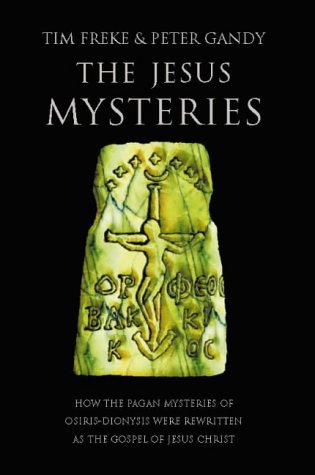
 |
Freethought & Rationalism ArchiveThe archives are read only. |
|
|
#1 | |
|
Veteran Member
Join Date: Apr 2003
Location: Australia
Posts: 5,714
|
Does anyone have any information about Freke&Gandy's amulet of Orpheus being supposedly crucified, that they use on the cover of their book, "The Jesus Mysteries"?
They said that it was in the Museum of Berlin, but disappeared during WWII. However, they provide no named source for the amulet. In fact, the only thing they say about it is: Quote:
Has anyone ever heard anything about this amulet? 
|
|
|
|
|
|
#2 |
|
Veteran Member
Join Date: Apr 2003
Location: Australia
Posts: 5,714
|
The only other thing that F&G say about the amulet is that it is dated to the 3rd C CE. They give no reason how they got this date, but I assume they got it from the "old academic book".
There are lots of references to this amulet on the net, but most seem to have their origin in TJM. The rest don't have any further information, though some give different dates, like 2nd C AD and 3rd C BC. |
|
|
|
|
#3 |
|
Contributor
Join Date: Jan 2001
Location: Barrayar
Posts: 11,866
|
PM Bede. I recall that he had looked into the matter.
Vorkosigan |
|
|
|
|
#4 |
|
Contributor
Join Date: Jun 2000
Location: Los Angeles area
Posts: 40,549
|
That picture on the front of the Jesus Mysteries - thread started by Bede, contains some good information, including a communication from Freke.
|
|
|
|
|
#5 | |
|
Veteran Member
Join Date: Apr 2003
Location: Australia
Posts: 5,714
|
Quote:
It does indeed look like an anchor cross. Freke's comment that "we are not making any spectacular claims about the amulet at all" is consistent with their style throughout the book. They leave that up to the reader to assume. Certainly a lot of others who have it on their own websites have little doubts about what it means. But AFAICS, they still haven't said anything about "the old academic book" in which they found the image. Has Freke or Gandy ever given that information out on the JM forum? The lack of title, author and location seems a glaring and obvious omission from their book. Surely even TJM supporters would have asked F&G about it? Hmmm... Perhaps I'll need to follow this up with F&G themselves. |
|
|
|
|
|
#6 |
|
Guest
Posts: n/a
|
Well, I emailed them and Peter Gandy said the amulet is featured in the following books:
Guthrie W K C, "Orpheus and Greek Religion" Princeton University Press, 1952. Eisler R, "Orpheus the Fisher" Kessinger Publishing (reprints), first published 1920. So, it's off to the library ot have a look. I doubt we will find much more than we knew already but there might be some interesting commentary. Yours Bede Bede's Library - faith and reason |
|
|
#7 |
|
Veteran Member
Join Date: Dec 2003
Location: A Windswept Hill on the Prairie Peninsula
Posts: 1,073
|
I do quite a bit of stone carving, and that amulet looks modern made to me. Look how crisp the edges of the incised designs are. The stars at the top have fine detail, and these would surely show wear in a 2000 yr. old piece. I would also expect to see much wear and possibly discoloration near the indentations on either side toward the top. These "notches" are presumably for suspension.
While it was pictured in a 1920's book, this is still no guarantee that it is authentic. Thousands of "authentic Indian artifacts" were made during the depression of the 30's in the US by clever poor people trying to get a dollar to buy food. City folks with money that came to the country to buy "Injun rocks" for 10-cents on the dollar got a bit more (or less) than they bargained for. I'd love to examine this piece in person, but alas, this purported evidence doesn't seem to be available. I may have to make up an amulet like that one just for fun. 
|
|
|
|
|
#8 | ||
|
Veteran Member
Join Date: Apr 2003
Location: Australia
Posts: 5,714
|
Quote:
Quote:
|
||
|
|
|
|
#9 | |
|
Contributor
Join Date: Jun 2000
Location: Los Angeles area
Posts: 40,549
|
Guthrie W K C, "Orpheus and Greek Religion" Princeton University Press, 1952
can be searched on Amazon. A line drawing of the amulet is at p. 265 (search for "amulet") Text p. 265-6: Quote:
|
|
|
|
|
|
#10 | |
|
Veteran Member
Join Date: Apr 2003
Location: Australia
Posts: 5,714
|
Quote:
Both books are listed in F&G's bibliography, though they don't cite either with regards to the amulet. I think we can see why - Guthrie goes on to quote Justin Martyr as saying "the pagans never imitated the crucifixion" and says "this testimony [by Justin Martyr] goes further to weaken a case for which not even its learned author liked to claim volle Sicherfeit" - though Guthrie himself finds the amulet of "the greatest interest" and "deserves to be more widely known". (Ed to add) Guthrie says that the amulet is in the Museum of Berlin, but I see nothing there that says that the amulet disappeared around WWII, and Eisler (1920s) is too early to have known. So I wonder where that piece of information came from? |
|
|
|
| Thread Tools | Search this Thread |
|